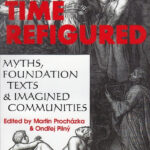Do you have a book manuscript or thesis that you would like to get published in English but it’s not ready for publication in its current form? You have googled “How much does it cost to get a book edited” or “How do I get my book edited?” because you’re not sure what’s involved? Well, the process normally starts with an initial call between the author(s) or book editor(s) and the copy-editor to discuss the content, volume, schedule and estimated costs.
 Editing is normally billed at an hourly rate, with the estimated number of hours depending on various factors such as the length, whether it is a translation that needs to be reviewed and checked against the original, whether it was originally written in English or, indeed, a mixture of the two. Personally, I specialise in editing translations from German and Czech as well as manuscripts originally produced in British, US or other variants of English such as Hiberno-English.
Editing is normally billed at an hourly rate, with the estimated number of hours depending on various factors such as the length, whether it is a translation that needs to be reviewed and checked against the original, whether it was originally written in English or, indeed, a mixture of the two. Personally, I specialise in editing translations from German and Czech as well as manuscripts originally produced in British, US or other variants of English such as Hiberno-English.
 It is always wise to have a text for publication read by at least one other person even if you are writing in your first language. While a native-speaker author may mean fewer changes during the editing process, this is not always the case. On the other hand, if a volume is a collection of articles by different authors, the hours required for each contribution can vary widely and it may take time for the editor to become familiar with the style or voice of each author.
It is always wise to have a text for publication read by at least one other person even if you are writing in your first language. While a native-speaker author may mean fewer changes during the editing process, this is not always the case. On the other hand, if a volume is a collection of articles by different authors, the hours required for each contribution can vary widely and it may take time for the editor to become familiar with the style or voice of each author.
Before editing can begin, it’s important to establish a timeline for the work and to agree on a payment schedule. It’s not necessary for the entire manuscript to be completed at this stage. Especially for bigger projects, it is common for the author(s), the copy-editor and perhaps the translator to work in parallel to save time. But the editor needs to see some finished chapters, ideally, or at least draft versions, in order to be able to estimate the costs and time involved.
 When scheduling, please bear in mind that editing, particularly of heavy academic texts, requires intense concentration and an editor might typically do a maximum of four to six hours of billable editing in a working day, alongside admin and various other daily tasks that are all part and parcel of running a business. An editor in high demand may also have other smaller projects for regular clients alongside a book project. Sometimes these can be passed on to a trusted colleague to allow more focus on a big project, but this is not always possible. Also, when scheduling, it is wise to build in a buffer for unforeseen circumstances such as illness or other unexpected delays. These projects can take longer than planned, particularly if the final manuscript is longer than initially anticipated.
When scheduling, please bear in mind that editing, particularly of heavy academic texts, requires intense concentration and an editor might typically do a maximum of four to six hours of billable editing in a working day, alongside admin and various other daily tasks that are all part and parcel of running a business. An editor in high demand may also have other smaller projects for regular clients alongside a book project. Sometimes these can be passed on to a trusted colleague to allow more focus on a big project, but this is not always possible. Also, when scheduling, it is wise to build in a buffer for unforeseen circumstances such as illness or other unexpected delays. These projects can take longer than planned, particularly if the final manuscript is longer than initially anticipated.
 As mentioned above, in addition to the timeframe, a payment schedule for copy-editing also must be agreed in advance, normally with an initial advance payment, partial payment(s) upon partial delivery and then a final settlement on completion. At the outset, it is important to discuss whether any additional services are required, such as collating the manuscript and compiling the table of contents, or final proofs of the PDFs.
As mentioned above, in addition to the timeframe, a payment schedule for copy-editing also must be agreed in advance, normally with an initial advance payment, partial payment(s) upon partial delivery and then a final settlement on completion. At the outset, it is important to discuss whether any additional services are required, such as collating the manuscript and compiling the table of contents, or final proofs of the PDFs.
It should be agreed who is responsible for the bibliography; this would generally be the authors(s) or book editor(s). And the index, if included, could perhaps be handled by a student assistant in a university or institutional setting if it is not too complicated, for instance, only an index of names; otherwise, use a professional indexer. There is also the cover design and front matter to consider, as well as the blurb on the book cover(s) and other potential advertising material, such as on the publisher’s website. These details should not be neglected as sub-standard texts here can harm the reputation of the publication. The acknowledgements need to be edited, too.
 Editing a manuscript means more than merely correcting grammar and/or spelling. It also involves suggesting stylistic changes and sometimes dividing up long sentences or long paragraphs. A good book editor also fact checks things such as names of people, places and institutions or dates and figures and ensures consistency throughout the manuscript. A professional copy-editor follows the style guide for the relevant publisher, if available, or a standard style guide such as Chicago Manual of Style (CMOS) for US English or Oxford University Press (OUP) for British English. Of course, it saves time if the author and translator, if applicable, also follow the relevant style guide and format the references accordingly from the outset. When editing, I make suggestions using the “track changes” function, highlight anything that might need double checking and write comments for the author(s). Questions can be cleared up either by email or phone/WhatsApp/Zoom calls, ideally as we go along, for example, at the end of each up chapter, so there are not too many issues left to resolve at the end.
Editing a manuscript means more than merely correcting grammar and/or spelling. It also involves suggesting stylistic changes and sometimes dividing up long sentences or long paragraphs. A good book editor also fact checks things such as names of people, places and institutions or dates and figures and ensures consistency throughout the manuscript. A professional copy-editor follows the style guide for the relevant publisher, if available, or a standard style guide such as Chicago Manual of Style (CMOS) for US English or Oxford University Press (OUP) for British English. Of course, it saves time if the author and translator, if applicable, also follow the relevant style guide and format the references accordingly from the outset. When editing, I make suggestions using the “track changes” function, highlight anything that might need double checking and write comments for the author(s). Questions can be cleared up either by email or phone/WhatsApp/Zoom calls, ideally as we go along, for example, at the end of each up chapter, so there are not too many issues left to resolve at the end.
The manuscript should be proofread after editing and before typesetting, either by the author or volume editor(s), the translator or the copy-editor. For hyphenation, it is essential to have the language set for the relevant version of English, such as British English or US English, as hyphenation rules vary for different languages and different variants of English. After typesetting, the PDFs should be checked, normally in two rounds of proofs. This might be done by the translator or copy-editor or by a colleague not involved in the translation or copy-editing and therefore reading the manuscript with fresh eyes. If there are any graphics, these also need to be checked, ensuring that they are in the right place and all the data and terminology match up with the main text.
Writing a book is a major endeavour that can take several years to complete. Considering all the hard work involved, you will want the final product to be of the highest possible quality. It is worth investing in a professional copy-editor to assist you in achieving this. If you have been wondering “How can I get my book edited?”, please don’t hesitate to get in touch. I will be happy to help you get your manuscript published in English.
Photos all of books edited/co-edited by Linda Jayne Turner. Blog post edited by Robin Finesilver.


